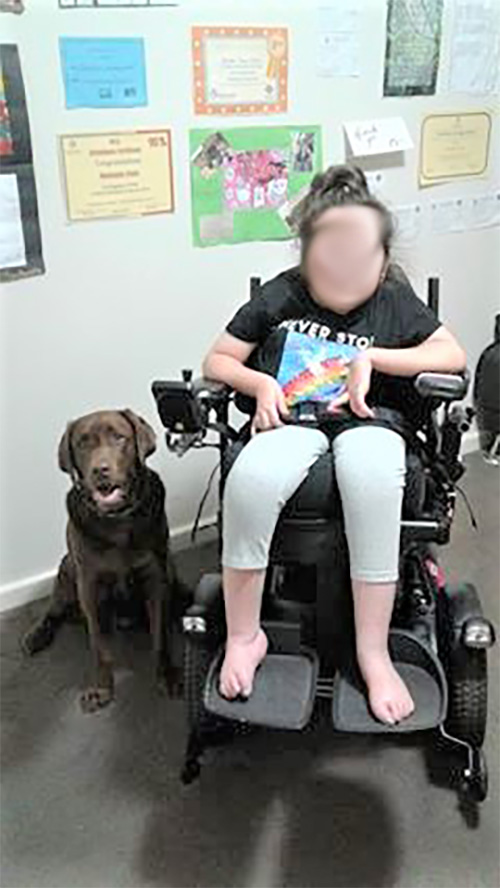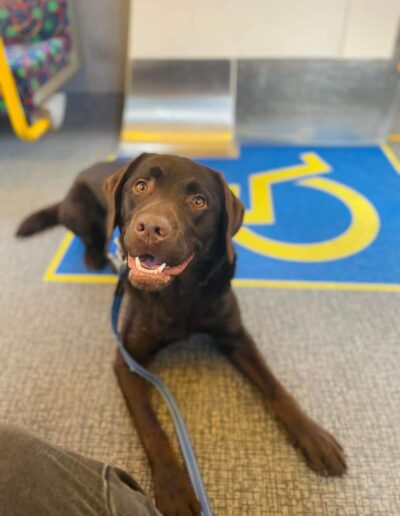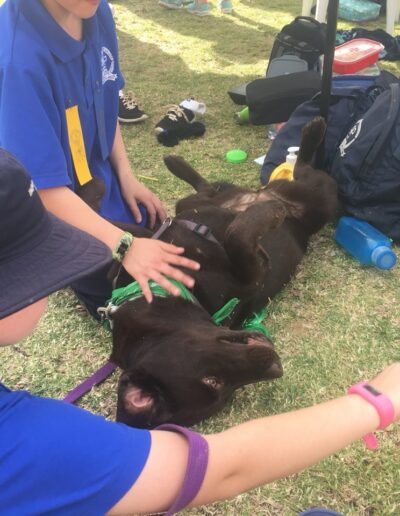Dog roles
Breeding for Assistance Dog Pups
In various places across this website you’ve seen us mentioning that our dogs are bred specifically as Assistance and Therapy dogs. But what exactly does that mean? An Assistance dog is, in essence, a dog who’s capable of helping a person in their everyday life. Whether this be to keep them calm in difficult situations, help them to overcome anxiety, alert to sugar highs and lows or to warn of impending seizures, and so much more.
Expertise & Insight
Our Experience
We at Valinka have a strong background in working with people who have special needs, so when people start listing acronyms like ASD, PTSD, OCD, and ADHD, we not only know what those conditions are, but we are well aware of what struggles are faced by the sufferer and their families alike, and what sort of assistance they will need from a dog
We also know what our dogs are capable of, and can steer people toward the litter, and the individual puppy, who will fulfill those needs. But, you must remember, we are providing a puppy with the potential to make a great Assistance dog, and not a fully trained animal.

Supply & Demand
Demand is up, supply is down…
Many people who enquire about a puppy are in the process of finding out if an Assistance dog is for them, or trying to work out the process of how to go from buying a puppy to having a fully trained and functioning Assistance dog.
This is not because other people don’t have a genuine need, but it’s because there are so few dogs available that organisations concentrate on those who they can help the most successfully. For those people who fall through the abys of a the “cracks” in the criteria, they are left with the options of either not getting a dog, or becoming an owner-trainer. And this is usually the point at which people are led to our website.
Training Journey
Owner-Trainers
Becoming an owner-trainer is a long and difficult process, and you can’t do it alone. Once you have the perfect puppy, you then need to engage the perfect trainer, and also surround yourselves with several good friends or family members who can help with the training from time to time. Your trainer needs to be one with whom you “gel”, and someone who gets you and your needs. Don’t be afraid to change trainers if you don’t feel the current one is the right fit for you. Changing is not a reflection of the quality of their work, or their abilities as an Assistance dog trainer, it’s just a sign that your two personalities don’t mesh together. And you do need someone who does get you. This is someone who will be in your life for at least the next two years, and probably longer.
Owner-training an Assistance puppy can be amazingly rewarding but, if you’re not properly prepared, it can end in failure and you will simply be adding a pet puppy to your household.
Assistance Dog Defined
What is an Assistance Dog?
Essentially, an Assistance dog is a dog who has been trained to help a person with special needs to go about their daily lives, or to function normally within society. This special-needs person is usually someone with a physical or cognitive disability, emotional disfunction, or a medical condition that effects their lives significantly. The benefits of Assistance dogs are slowly being recognised throughout society, although gaining funding for the private purchase and training of an Assistance dog is still tremendously difficult through NDIS. Hopefully that will change in the near future.
The Differences
An Assistance dog differs from a Therapy dog or Emotional Support animal in one major way, the PAT qualification. The Public Access Test. Once a dog has passed their PAT, they have the same legal rights as a Guide dog or Seeing eye Dog. They are permitted into shopping centres, onto buses, trains, or taxis, into restaurants, movie theatres, hospitals or medical centres, even on a plane (and not in the cargo hold, but in the cabin with their owner, either under their seat or in a seat of their own). The dog has proven themselves safe within society, and the government can be 99% certain they will not bite, run off, startle, or show fear in public, nor walk their human out into oncoming traffic. This qualification sets them apart from all other dogs, and it’s a difficult test to pass.
Training
Companion & Support
What is a Therapy Dog?
There are generally two types of therapy dogs. One is a dog who can emotional support and comfort to a lot of people. This can be in a private home setting, or in more public settings, such as in hospitals, nursing homes, or workplaces. The dog isn’t bonded to one person in particular, they don’t have a special person, but are trained to be calm and relaxed in all settings, and are generally quite friendly and social with all people. The other type of therapy dog is one who does have a special person, and may have even been trained part or most of the way towards being an Assistance dog, but they haven’t become qualified. Sometimes a family doesn’t need a dog to be out in public, but just to provide assistance in the home, so the full Assistance Dog qualifications aren’t necessary. Once the dog is working as they need them to, families will often stop the training.
Therapy dogs DON’T have public access rights, and haven’t passed their PAT. They can go into public places, businesses and private residences, hospitals, etc. but only with the permission of the owner/administrator.
Natural Comforters
What is an Emotional Support animal?
An emotional support animal is usually an animal who hasn’t received any specialised training, but one who is naturally intuitive, or supportive, to either their special person or just to people in general. They can be any type of animal from a rat to a horse, and all sizes in between. It’s the emotional support they offer to people that counts, not their ability to perform certain tasks. Often people will want to take their emotional support animal with them out into the community, onto buses or trains, but this is not allowed by law. An emotional support animal is untrained, and while they can go places with the permission of those who own or run that particular place, taking an emotional support animal out with you into the community is not a given right.
Assistance Dog Tasks
What can an Assistance dog do?
How long is a piece of string? I don’t think the full potential of the canine companion has even been contemplated yet, let alone reached. Everyone knows about dogs being used as hunting companions to their human keepers; this has been happening for more than forty thousand years. But these days they also excel as police detection dogs, guard dogs, scent detection dogs (for anything from drugs, to money, or even to food), and guide dogs for the blind. They have even experimented with dogs to detect cancer, covid19, and other diseases. As far as Assistance dogs go, below are some of the more common uses that we have encountered.
Diabetic Alert Dog
Seizure Alert Dog
Similar to a diabetic alert, in that the dog is trained to warn their special person, or a parent/carer, when an epileptic seizure is imminent. The person can then prepare themselves for the seizure: lay down or get into a comfortable and safe position, take additional medication if needed, call or alert anyone if it’s warranted. Again, the alerting part of the education process is the easy bit. Dogs can smell so much more than we can. They already know the scent of a seizure, all we have to do is teach them what to do when they smell that smell. A Seizure Alert dog is capable of so much more than to simply alert to an imminent seizure. They can retrieve medication if needed. Bring the phone to their special person. Go and tell someone else that a seizure is imminent or has happened. They stay with their person during the seizure, removing objects from harm’s way if needed. Once the seizure is passed, they can perform deep pressure therapy to bring their special person back to full awareness, which includes laying on their chest, licking of the hands and neck, or nudging to wake them up. If their person remains unresponsive, as with the Diabetic alert dogs, the Seizure alert dog can go and find help, press an emergency button in the house if one is fitted, and so on.
PTSD Assistance
Post Traumatic Stress Disorder is often suffered by our returned servicemen/women, or victims of trauma, domestic violence or crime. A sufferer often experiences “triggers” in every day life, little things which bring them straight back to the traumatic event, or they may find they become anxious, confused, and upset very easily. Here an Assistance dog helps people to regulate these reactions. Dogs can smell when someone’s emotions are becoming unbalanced, or when they are starting to spiral, often long before the sufferer is even aware of it. The dog offers comfort, and is taught in a variety of diversion activities to break the downward emotional spiral. For the sufferer, the benefits of an Assistance dog are quite literally life changing.
ASD Assistance dog
Anxiety, Depression, and other Mental Health Disorders
Guide dogs
Physical Assistance dogs
Labrador Advantages
What makes the Labrador so good for Assistance work?
Most people know that Labradors are one of the smartest, and most easily trained, dogs in the world. But so is the Kelpie, Border Collie, Poodle, German Shepherd or the Beagle. So, what makes the Labrador so special for Assistance work? It takes a lot more than smarts to be a good Assistance dog. You need to be calm, stable, loyal, gentle and loving as well, plus forceful and a little stubborn. That’s a tough combination to meet.
Smart and Stable
Loyalty
Gentle
Love People
We have also taken the natural bond that Labradors have with people and made it stronger. They will often prefer the company of people over other dogs. An Assistance dog needs the company of people, and their favourite place is with their special person. It’s a biological drive.
Love of Food
Our Recommendations
While we have worked with a number of people and organisations over the years, who are capable of training Assistance dogs, there is now one group which has begun to stand out from the others. WAAT Dogs, the West Australian Assistance and Therapy Dogs. They are a not-for-profit group that specialises in educating owner-trainers and Assistance dogs alike. They have a pool of qualified trainers who help families through the process of turning their bundle of puppy kisses into a functioning Assistance Dog. It is not a free service, you still have to pay for the training, but they’re not a corporation out to make a massive profit. They are just a group of dedicated and enthusiastic people intent on seeing as many people as possible access the help they need in raising Assistance dogs. I have also included the contact details for other, individual, Assistance Trainers that we’ve had contact with in recent years.
WAAT Dogs
(08) 9228-3647
www.waatdogs.org.au
Get in touch
Contact us
Address
A. 82 Peters Road, Muchea, 6501
(Prideland Kennels and Cattery)
M. PO Box 237, Muchea, 6501
Phone or email
P. (08) 9571 0677
M. +61 414 898 236










